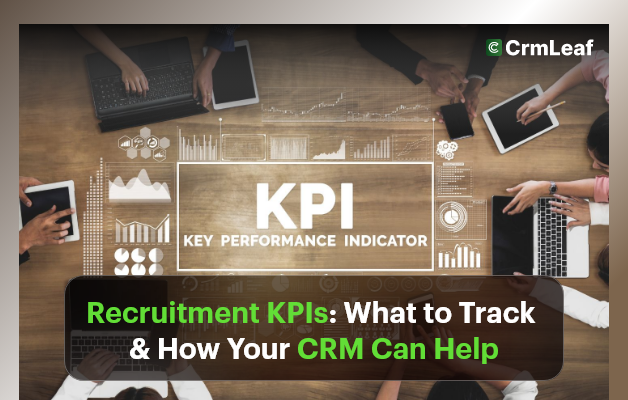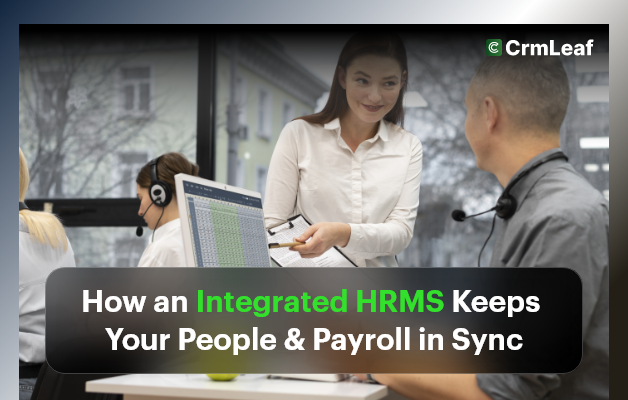Recruitment KPIs are no longer “nice-to-track” metrics — they’re business-critical. In today’s competitive hiring market, companies that fail to optimize recruitment performance risk losing top talent and wasting resources.
According to LinkedIn’s Global Recruiting Trends Report, 77% of talent leaders say their hiring decisions are increasingly driven by data. But here’s the catch — many HR teams still track metrics manually or in silos, leading to inconsistent results and poor visibility.
This blog will walk you through the most important Recruitment KPIs, how to track them effectively, and why integrating these metrics into a CRM + ERP system like CRMLeaf makes all the difference. Whether you’re hiring in retail, manufacturing, or tech, you’ll learn actionable strategies to sharpen your recruitment game.
Why Tracking Recruitment KPIs is Critical for Growing Businesses
Recruiting is no longer just about filling roles — it’s about building scalable, high-performing teams. And that requires data-driven decision-making. Here’s why every growing business should prioritize Recruitment KPIs:
Optimize Hiring Performance
Tracking key metrics gives you real-time insights into what’s working — and what’s not. Without this visibility, it’s hard to fix bottlenecks or repeat successful strategies.
Reduce Time & Cost Per Hire
When you monitor time-to-fill and cost-per-hire, you can streamline your process, avoid unnecessary expenses, and increase ROI on recruitment efforts.
Improve Candidate Quality
Metrics like quality of hire and candidate source effectiveness ensure you’re not just hiring faster — but smarter.
Align HR With Business Goals
KPIs create a shared language between HR, operations, and finance. They help you justify hiring budgets and demonstrate how recruitment impacts business performance.
Industry Scenarios
- Retail: High seasonal turnover demands tight tracking of time-to-fill and offer acceptance rates.
- Manufacturing: Cost-per-hire and training effectiveness are crucial for maintaining margins.
- Tech: Fast-scaling startups need to monitor candidate pipeline velocity and source quality closely.
By centralizing these metrics in a CRM + ERP like CRMLeaf, businesses get a single source of truth that connects people, processes, and performance.
Essential Recruitment KPIs to Track (And How Your CRM Helps)
Let’s dive into the Recruitment KPIs that every HR team should monitor — and how a CRM-integrated recruitment system makes this easier, faster, and smarter.
1. Time to Hire
Tracks the number of days between first contact with a candidate and their acceptance of the offer. A long time-to-hire could mean bottlenecks in interviews or approvals.
CRMLeaf’s automation features send reminders, schedule interviews, and move candidates through the pipeline — cutting time-to-hire significantly.
2. Cost per Hire
Calculates the total recruitment cost (job ads, agency fees, time spent, onboarding) divided by the number of hires. This helps you allocate budget wisely.
CRMLeaf’s integrated finance module links hiring activity with real costs, so you get real-time cost-per-hire insights.
3. Quality of Hire
Measures how well new hires perform, stay, and grow within the company. Often tracked via performance reviews, retention, and manager feedback.
CRMLeaf can pull post-hire performance data directly into your hiring dashboards, connecting recruitment to long-term value.
4. Candidate Source Effectiveness
Identifies which channels (job boards, social media, referrals) deliver the best candidates in terms of quality, cost, and speed.
With CRMLeaf, source tracking is automatic. You can compare platforms, campaigns, and recruiters — all from one dashboard.
5. Offer Acceptance Rate
Percentage of job offers accepted versus total offers made. A low rate may signal poor candidate experience or uncompetitive compensation.
CRMLeaf tracks offer stages, feedback, and status changes, allowing HR teams to analyze drop-offs and improve offer conversion.
6. Application Completion Rate
Measures how many candidates complete your job application process. A low rate means friction — perhaps the form is too long or unclear.
Use CRMLeaf to run A/B tests on forms, simplify workflows, and monitor which roles or campaigns have high abandonment.
7. Diversity Metrics
Track the representation of different demographic groups in your hiring pipeline. This helps ensure fair and inclusive hiring practices.
CRMLeaf enables anonymous data collection and diversity reporting that aligns with compliance and ESG goals.
8. Hiring Manager Satisfaction
Feedback from managers on the quality of candidates and the recruitment process. A low score signals misalignment or poor internal communication.
Built-in feedback surveys in CRMLeaf keep hiring managers engaged and help HR teams fine-tune their efforts.
Best Practices to Improve Recruitment KPIs with CRM + ERP
Improving Recruitment KPIs isn’t just about tracking more data — it’s about tracking the right data and acting on it. Here’s how to optimize your hiring with CRMLeaf’s CRM + ERP platform:
Automate Manual Steps
- Eliminate repetitive tasks like resume parsing, email follow-ups, and calendar scheduling.
- CRMLeaf’s automation reduces admin work, freeing recruiters to focus on human connections.
Standardize Candidate Workflows
- Use predefined pipelines for different roles or departments to ensure consistency and reduce time-to-hire.
- Create workflows in CRMLeaf that match your hiring stages — from screening to onboarding.
Integrate HR with Finance & Operations
- Align recruitment KPIs with budgets, team planning, and capacity needs.
- CRMLeaf gives a unified view of workforce demand, job requisitions, and financial impact.
Use Dashboards for Real-Time Visibility
- Set up visual dashboards that track all key hiring metrics in real time.
- CRMLeaf’s customizable reporting lets HR and leadership monitor performance at a glance.
Benchmark & Improve Continuously
- Track trends over time and compare against industry benchmarks.
- Use CRMLeaf to spot declining metrics early and act before it impacts team performance.
Customer Success Story
For example, TalentCraft Solutions, a fast-growing IT services company, used CRMLeaf’s Recruitment Module to reduce their average time-to-hire from 28 days to 14 days, while improving their offer acceptance rate by 22%. Here’s how:
- Implemented automated email sequences for faster communication.
- Used dashboard insights to prioritize job boards with higher conversion.
- Connected candidate performance reviews to hiring reports for ongoing learning.
This transformation helped them scale without burning out their HR team — and saved thousands in hiring costs.
Key Takeaways
Tracking Recruitment KPIs isn’t optional — it’s essential. With the right data, teams can make better decisions, reduce hiring friction, and build stronger teams. A CRM + ERP platform like CRMLeaf doesn’t just track metrics — it connects recruitment to every corner of your business, from HR and finance to operations and beyond.
Focus on metrics like time-to-hire, cost-per-hire, and source effectiveness. Automate what you can, standardize workflows, and always keep the candidate experience at the center.


